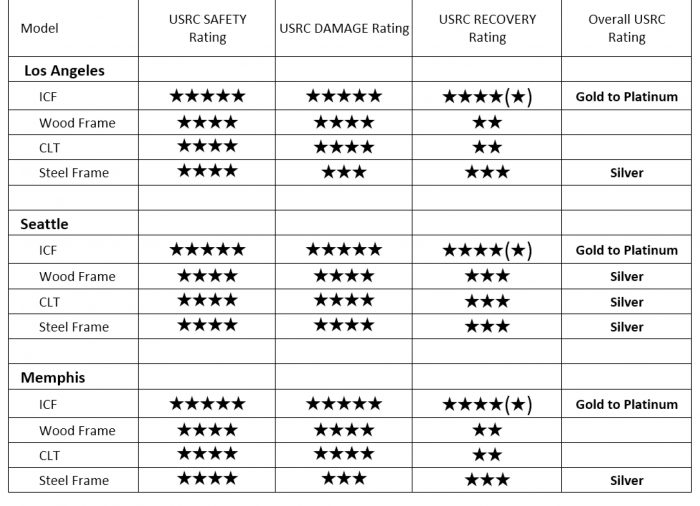Sources: RMC Research & Education Foundation, National Ready Mixed Concrete Association, Alexandria, Va.; CP staff
A U.S. Resiliency Council (USCR) report prepared for NRMCA and the RMC Research & Education Foundation evaluates comparative seismic performance of four commonly used construction types—insulating concrete form, traditional wood, cross laminated timber, steel —for a typical multifamily development in Los Angeles, Seattle, and Memphis. The template applied to each method/material entailed a four-level apartment, 360- x 68-ft., totaling 98,000 square feet.

Using RS Means data, “Earthquake Performance Comparison of Multifamily, Multistory Apartment Building Constructed of Various Materials” investigators and authors estimated net costs by method/material and location:
• ICF walls with precast concrete floor slabs, $15.6 million to $20.5 million, depending on city;
• Traditional stick frame with dimensional lumber floor joists and plywood floor diaphragms;
$14.1 million to $20 million;
•Traditional stick frame lumber with cross laminated floor diaphragms, $15.1 million to $21.7 million; and,
• Hot rolled steel framing with concrete topped metal deck floor diaphragms, $16.3 million to $21.5 million.
USRC calculated the net benefits and construction cost differences of ICF against the other three configurations and estimated a potential return on investment considering earthquakes that might occur over a 50-year building life. Benefits included reduced property loss and rental losses associated with the strength and stiffness of each. Potential losses not considered included contents, injuries, shelter needs, workforce losses, tax revenues, debris costs and environmental impacts. Among key Council findings:
• The ICF configuration produced an 18 percent to 80 percent higher lateral force strength and four to five times higher building stiffness than the other configurations.
• Property losses in a Design Level Event were approximately 170 percent to 270 percent higher for the wood, CLT and steel configurations than the ICF model in Los Angeles and Seattle, and 40 percent to 85 percent higher in Memphis.
• Estimated recovery times in a Design Level Event for the ICF configuration were typically less than two weeks versus 6.5 to 9.5 months in Los Angeles and Seattle and 1.5 to 5.5 months in Memphis for the wood, CLT and steel alternatives.
• Total losses, considering property and rent were approximately 270 percent to 530 percent higher for the wood, CLT and steel configurations than the ICF configuration in Los Angeles and Seattle, and 85 percent to 130 percent higher in Memphis.
“We’re proud to work with our partners at NRMCA to release this illuminating USRC report,” says Foundation Chairman Rodney Grogan (Dunn Investment Co./MMC Materials). “It’s important to understand the true costs of building material selection, especially in areas subject to natural disasters.”
“Our industry has long recognized the benefits of resilient construction,” adds NRMCA Vice President, Fire Codes & Standards Shamim Rashid-Sumar, P.E. “The USRC study quantifies these benefits beyond first construction costs to include the impacts of damage, repair, and recovery time.”
The USCR report is posted here.
Earthquake Performance Comparison of Multifamily, Multistory Apartment Building

Related Article
RMC Foundation concrete strength model picks up where Abrams left off